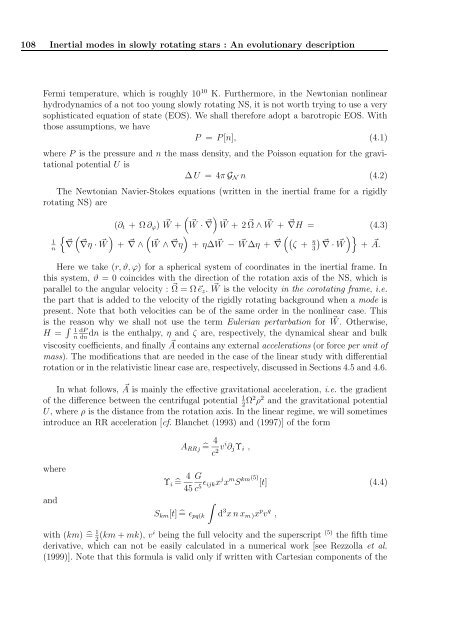Ecole doctorale de Physique de la région Parisienne (ED107)
Ecole doctorale de Physique de la région Parisienne (ED107)
Ecole doctorale de Physique de la région Parisienne (ED107)
You also want an ePaper? Increase the reach of your titles
YUMPU automatically turns print PDFs into web optimized ePapers that Google loves.
108 Inertial mo<strong>de</strong>s in slowly rotating stars : An evolutionary <strong>de</strong>scription<br />
Fermi temperature, which is roughly 10 10 K. Furthermore, in the Newtonian nonlinear<br />
hydrodynamics of a not too young slowly rotating NS, it is not worth trying to use a very<br />
sophisticated equation of state (EOS). We shall therefore adopt a barotropic EOS. With<br />
those assumptions, we have<br />
P = P [n], (4.1)<br />
where P is the pressure and n the mass <strong>de</strong>nsity, and the Poisson equation for the gravitational<br />
potential U is<br />
∆ U = 4π GN n (4.2)<br />
The Newtonian Navier-Stokes equations (written in the inertial frame for a rigidly<br />
rotating NS) are<br />
(∂t + Ω ∂ϕ) <br />
W + W · ∇<br />
W + 2 Ω ∧ W + ∇H = (4.3)<br />
<br />
1 ∇ ∇η · W<br />
+ n<br />
<br />
∇ ∧ W ∧ ∇η + η∆ W − W ∆η + ζ <br />
η<br />
∇ + ∇ · W<br />
+ 3<br />
A.<br />
Here we take (r, ϑ, ϕ) for a spherical system of coordinates in the inertial frame. In<br />
this system, ϑ = 0 coinci<strong>de</strong>s with the direction of the rotation axis of the NS, which is<br />
parallel to the angu<strong>la</strong>r velocity : Ω = Ω ez. W is the velocity in the corotating frame, i.e.<br />
the part that is ad<strong>de</strong>d to the velocity of the rigidly rotating background when a mo<strong>de</strong> is<br />
present. Note that both velocities can be of the same or<strong>de</strong>r in the nonlinear case. This<br />
is the reason why we shall not use the term Eulerian perturbation for W . Otherwise,<br />
H = 1 dP dn is the enthalpy, η and ζ are, respectively, the dynamical shear and bulk<br />
n dn<br />
viscosity coefficients, and finally A contains any external accelerations (or force per unit of<br />
mass). The modifications that are nee<strong>de</strong>d in the case of the linear study with differential<br />
rotation or in the re<strong>la</strong>tivistic linear case are, respectively, discussed in Sections 4.5 and 4.6.<br />
In what follows, A is mainly the effective gravitational acceleration, i.e. the gradient<br />
of the difference between the centrifugal potential 1<br />
2 Ω2 ρ 2 and the gravitational potential<br />
U, where ρ is the distance from the rotation axis. In the linear regime, we will sometimes<br />
introduce an RR acceleration [cf. B<strong>la</strong>nchet (1993) and (1997)] of the form<br />
where<br />
and<br />
ARRj = 4<br />
c 2 vi ∂jΥi ,<br />
Υi = 4 G<br />
45<br />
Skm[t] = ɛpq(k<br />
c 5 ɛijkx j x m S km(5) [t] (4.4)<br />
<br />
d 3 x n xm )x p v q ,<br />
with (km) = 1<br />
2 (km + mk), vi being the full velocity and the superscript (5) the fifth time<br />
<strong>de</strong>rivative, which can not be easily calcu<strong>la</strong>ted in a numerical work [see Rezzol<strong>la</strong> et al.<br />
(1999)]. Note that this formu<strong>la</strong> is valid only if written with Cartesian components of the
















